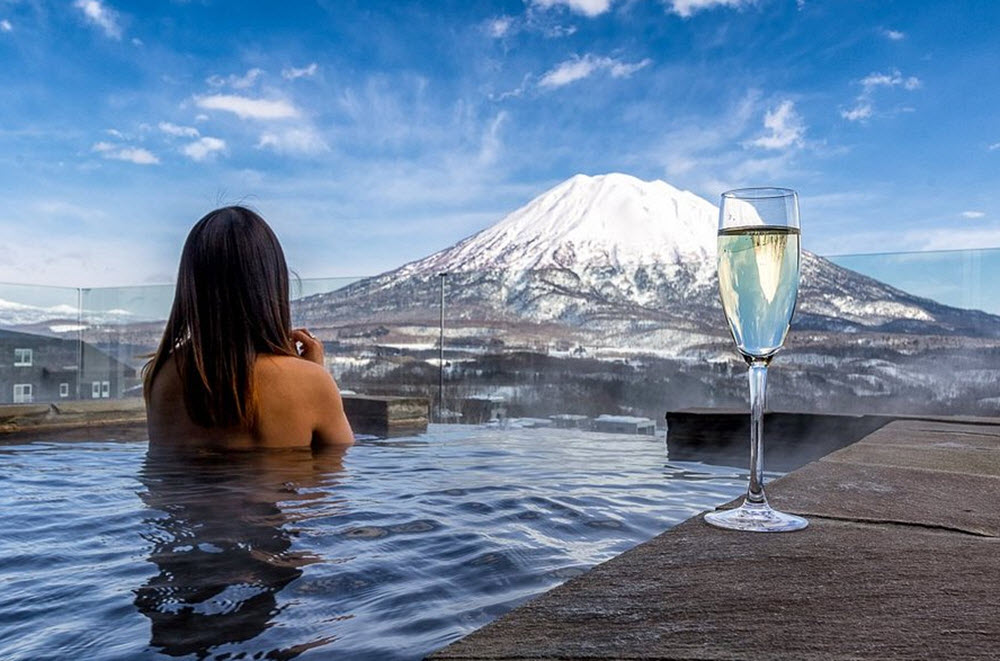Contents
The Vale Niseko is one of only a handful of ski-in ski-out buildings in the ski area Niseko on Japan´s northern island Hokkaidō.
Built between June 2008 and December 2009, The Vale Niseko is a serviced apartment and condo property placed on the ski run in upper Hirafu Village. With a total of 49 residences, it is the largest residential single complex in Niseko. Some of units are available for rent, while others have been purchased by individuals and are used as homes or holiday homes.
The Vale Niseko was completed in early December, on schedule for the popular winter season in Niseko. The ski season in Niseko runs from late November to early May, and nine days after opening, the building had reached 100% occupancy.
Where is The Vale Niseko?
The Vale Niseko is located on the ski run in upper Hirafu Village, Niseko, Hokkaidō, Japan.
Coordinates: 42°51′N 140°42′E
The building sits at the base of the Family Run, roughly 120 metres from the village centre.
Short facts about the construction of The Vale Niseko
Construction period: June 2008 – December 2009
Developer: NISADE Niseko Alpine Developments
Architect: Nikken Sekkei
Structural engineer: Nikken Sekkei
Interior design: Nikken Space Design
Main contractor: Nakayama Gumi
Architecture
In the sparsely built-up Hirafu Village, the 7-storey Vale Niseko can be seen from almost anywhere and has become a local landmark. It is a building inspired by both Japanese and European styles.
The base of the building is stone, while the panelling above is made from timber cedar, and this choice of materials is a nod to the local alpine environment. Inside the units, guests can enjoy alpine stone features and fireplaces. The bathrooms are Japanese-style.
At the drawing board, architect Hokkaido Nikken Sekkei opted to shape the building around each unit´s view, aiming to give each unit the best possible views from each of the rooms. Unsurprisingly, the building is dominated by large windows, including plenty of floor-to-ceiling installations, and the façade incorporates semi-frameless glass balconies.
To ensure that the ski run views are not disturbed in the future, Niseko Alpine Developments has purchased neighbouring land on the ski run by the Vale Niseko building.
Amenities includes an outdoor heated pool, an aprés ski terrace, restaurant and bar, and natural thermal hot spring baths (“onsens”) that get their water from a 700 metre deep well. Private onsens that look up the ski run are available, and this is where the ancient Japanese onsen tradition mixes with ultra-modern design elements.
What is Niseko?
Niseko is a town in Japan´s Shiribeshi Subprefecture, but the name is also widely used to denote the local mountain range and the ski resort area on Mount Yōtei and Annupuri.
In the now nearly extinct Hokkaido Ainu language, Niseko means ”a cliff jutting over a riverbank deep in the mountains”.
Niseko is famous for its high-quality power snow and traditional onsens. Even though the town itself has less than 5,000 residents, it is visited by 200,000+ people during the winter season. Both domestic and foreign-owned companies are currently developing real-estate in Niseko to handle the influx of visitors, including skiing enthusiasts who wish to buy real estate rather than just stay in hotels or rent a condo short-term.
Skiing in Niseko
There are several ski areas. The main four are Hirafu, Annupuri, Hanazono and Higashiyama (also known as Niseko Village). They are sequentially interconnected and use the same ski pass. The other ski areas are Moiwa, Weiss and Park Hyatt. It should be noted that Hirafu, Hanazono and Weiss belong to the Kutchan municipality; while the others are part of the Niseko municipality.
Sannozaka is an unofficial backcountry ski-course prone to avalanches. Despite the dangers, advanced skiers seek it out due to its high-quality snow. Another option (also risky in regards to avalanches) is Higashi One, known for its challenging terrain.
Niseko is found in northern Japan, and it´s geographical location means that it is dominated more by weather fronts from Siberia than by warmer air from eastern Japan. In the winter, you can expect a lot of northwest-to-southeast Siberian winds and plenty of light powder snow. The snow is not as dry as in certain other areas of Hokkaido, but the volume is high and reliable. In March, it is not uncommon for the snow depth to be 350+ cm.

